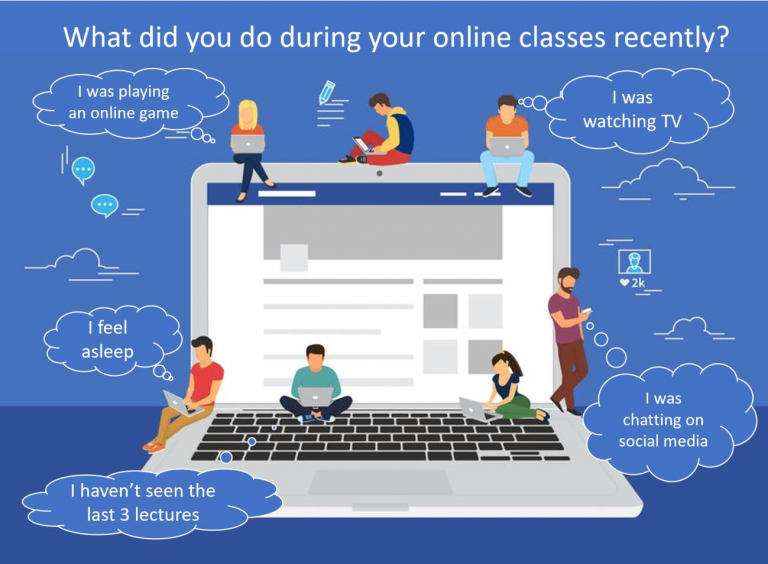
“I fell asleep”.
“I was playing an online game”.
“I was watching TV”.
“I was chatting with friends on social media”.
“I haven’t seen the last 3 lectures”.
These are some the answers from university students when asked about what they did during their virtual classes recently. With such answers, one has to wonder – are they learning anything in the online classes?
The pandemic has forced most educational institutions and training organizations into using online classes across the world. To make the adjustment, these organizations have thrown a piece of technology, such as Zoom or Google, at the educators. Unfortunately, such practices greatly limit the amount of learning that happens during these classes. Teaching online is like asking people who know how to drive to fly a plane. Educators need additional skills and beliefs in order to teach in an online environment and enable learning. Especially with the Asian priority on education, institutions need to have a development system in place to make sure their students are learning in the best ways possible.
What defines learning?
Many people seem to mistake learning with some activity that obtains information. But, when that information never becomes knowledge, learning doesn’t happen. Ask yourself – how much (percentage) do you remember from the last training workshop or class you participated in? And what of that information you do remember, can you use it effectively? As an educator/trainer, we all wish the answer to these questions would be as high as possible. To achieve this, your fundamental belief about what learning is must be reflective of the function of learning in the human brain.
Let’s start from the beginning. The human brain receives over 400 billion of bites of information each second. Only 2000 of those are bites are in our awareness being processed 1. This tells us that most of what we get has no chance at becoming durable knowledge. For learning to happen, a piece of information has to have some emotional connection or meaning to become knowledge. A much more technical and accurate definition of learning looks at the outcome of learning, not the process of it. Learning should equate to a relatively permanent change in behavior and thought process (Ormrod & Jones, 2018). Simply put, if you don’t remember it, you’ve not learned. And, if you can’t use it, you’ve not developed the skills. To learn, one would translate the information into knowledge that has a relative permanence of recall and move toward developing the skills to effectively apply that knowledge.
Keys to Engagement and Learning in the Online Environment
As more and more institutions are pushed into the online learning environment due to social distancing, new skills and methods of teaching are needed for learning to occur. One cannot just do the same as they did in the face-to-face environment and expect the same results in the online environment. The following are some best practices from 19 years of online education from some of the world’s leading online institutions along with my doctoral studies in educational and organizational psychology.
- Lectures of 18 minutes or less: There’s nothing more boring that to listen/watch someone talk for 45 minutes or more in a virtual classroom. While this has been the norm across most Asian universities and training organizations, going online will require significant adjustments for learning to happen. On the educator side, it’s a lot of work to prepare for such lectures and presentations. On the student side, most of it won’t be remembered. Since auditory modality of learning results in the least amount of recall, there’s a reason why TED talks are always between 15-20 minutes2. In the online environment, designing lectures to be 18 minutes can be challenging when there’s so much content. One must balance the need to cover content with how much students will remember. Break the lecture into small segments of 18-minute or less lectures and design some activities in between to make them more meaningful and emotionally engaging for every student. This leads to the next best practice.
- Create meaningful learning: The human brain will consciously choose to process information when it’s meaningful. Otherwise, it gets lost in the 400 billion bits of information per second. To make learning meaningful, let’s start with a student inventory. Consider this like a medical chart, except with data relevant to learning. Content such as personal goals, core values, and interests should be gathered and available (Sun, Otoum, & Stetar, 2016). The specific skills that the student wants and needs to develop along with learning modality preferences should also be present. Using this information, the connection between course materials and one’s interests and needs can be easily made. Just as various leadership studies speak to the need to make work meaningful, learning that is meaningful gets remembered. In the online environment, there’s more time and a place for students to contribute to their inventory. Educators can take the time to gather and analyze them to effectively design the class to be meaningful.
- Apply learning modalities in delivery of content3: Every person has preferences when it comes to learning/communication modalities. Some are more visual, others are more kinesthetic, and a few are auditory. In the individual conversation, adapting to one’s preferred modality helps make communication much more efficient. In the online learning environment, adapting one’s content delivery towards the various learning modalities of the class/group makes information more memorable. Of course, this information has to be readily available, or extra efforts to assess the learning modality of the class would obtain the data to go into the student inventory. In the online environment, this can be done by assessing students’ introductory posts and exploring the choice of words they use, or with various psychometric assessments. It’s much easier to conduct this analysis in the online environment, since there’s more written by every student, than in the normal classroom where limited students can speak, and only auditory information is available. Once the analysis of the students’ learning modalities is available, design your lectures and activities to reflect the right amount of each modality. For example, if the class is predominantly visual learners, ample use of visual tools can facilitate engagement and learning.
- Design engaging activities: In-class activities are great teaching tools. Adapting them to the online environment calls for some creativity and understanding of the technologies being used. Most of the virtual tools being used have functions such as creating groups, making a quick poll, and shared Whiteboard. For example, one activity that’s always great to assess students’ understanding of the material is to ask them to critically apply it to a meaningful situation “in front of the class”. This can be done by requesting a few students to draw on the virtual Whiteboard and everyone else would see the same Whiteboard. Inviting participation and different viewpoints on the whiteboard is very easy and you don’t have to wait for students to walk to the blackboard. This would be an activity in divergent thinking. Of course, the activities should directly relate to both the class content and students interests from their inventory. Students should see these activities as challenging and fun, and not just another meaningless exercise for the sake of killing time. At the end of the activity, the educator would simply synthesize all of the ideas into something practical, illustrating convergent thinking. Such collaborative activities can help create new knowledge that’s meaningful for the students (Sun, 2015). In our university, we use cross-discipline faculty teams, along with an educational psychologist, to collaborate on innovative activities that connect our learners to the course materials. While this can take some time to develop as a skill, this team approach takes the weight off while making it an exciting challenge.
- Effective use of Socratic methods4: Using engaging questions shows a great deal of authentic care while enhances learning. Before we get into the specific practice, authentic care for students’ learning must be present to apply such a practice. When asking questions to engage students, use open ended questions that connect to the students’ interests and goals. This may be especially challenging for many traditional educators used to lecturing style of teaching. In an online environment, this can be done through using discussion forums as well, where each individual student gets to participate. Let’s take communication as a general example as the content of the class. A possible question that really engages students would be, “How would you apply this concept to better your relationship with your family?” Such a question enables every student to critically apply what they’ve just learned to something most care a great deal about. This type of question can be done with almost any topic of the class. This is not an easy skill to develop in a live conversation. The online environment is the perfect place to practice effective use of Socratic methods since most have a discussion forum. As educators read students’ post, they can practice by thinking through the questions and writing them in response posts to test the engagement level.

As you have seen, the best practices all work in concert with each other, just like music at a live concert. This is where institutions and training organizations can create the systems that enable the development of such skills and applications within a learning framework. Systemic thought in designing the desired online educational environment to achieve significant impacts in learning is crucial during and after the pandemic.
Applying learning to you
The best way to obtain a great return on your investment in time is to apply a few of these to your daily practices. Whether you’re an educator in a university or a professional training organization, apply some of the ideas to maximize the students’/participants’ recall and develop durable knowledge and skills. If you don’t apply it, you’ll likely forget most of this. This applies to any new information you get from various sources.
Let’s make the most learning happen in this challenging time while many people are quarantined. When you help people learn something meaningful, you help reduce the psychological damage from this pandemic. At the end of the day, we all want to walk away knowing that students continued to learn and we, as educators, continue to be the hope that lights their future.
Dr. Sun will be hosting a free workshop on Adapting to the Online learning environment on May 2, 2020 at 10 AM (Japan: GMT+9). Please click here to register.
About the author
Dr. Ted Sun is a global professor, consultant, author, and researcher who’s worked with universities and students across all major continents in both face-to-face and online environments. His online experiences date back to 2001 and have worked with universities across the world in both traditional settings and online environments. He is currently the Chief Innovations Officer at Transcontinental, which offers developmental partnerships to other universities/training organizations, in addition to educating and transforming students and organizational executives across the world. Contact the institution at [email protected]
References:
Ormrod, J. E., & Jones, B. (2018). Essentials of Educational Psychology: Big Ideas To Guide Effective Teaching (5th Edition). Upper Saddle River, NJ: Pearson.
Sun, T., Otoum, M., & Stetar, B. (2016, January). Global Discovery of Learner Motivations: Building a foundation for systemic enhancements within higher education. The Transnational Journal of Business, 1, 11-24.
Sun, T. (2015, Winter). TED Talk: Knowledge creation – capturing wisdom systemically. ACBSP Update.
Written by Richard Miller













